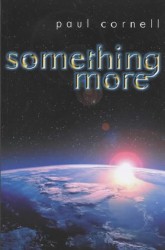

| . | ||
| Click on a book's image or title to order from Amazon.com |

Something More
Gollancz (UK), PB, © 2001, 422 pp, ISBN #1-85798-959-7Reviewed September 2004
Cornell apparently is one of the stable of writers who kept Doctor Who alive through original novels in the 1990s, and Something More is his first novel. I was aware of neither of these facts when I bought it - I was just intrigued by the synopsis I read on Amazon UK.
In 1922, Simon Trent builds the house of Heartsease in rural England, partly to commemorate his son, who died in World War I. In 1998, Booth Hawtrey - an unremarkable Englishman - is transformed into an alien being with a human mind by the Aurigans, the only other sentient life in the galaxy, who use Booth to explore the Earth on their behalf. Finally, in 2042, Earth suffers the General Economic Collapse (GEC), and slowly falls into feudal barbarism.
Two centuries later, in 2248, Booth Hawtrey is still alive and kicking, surveying the land (mainly the former UK) at the behest of the Aurigans. His official biographer is a young woman named Rebecca Champhert, who has been a soldier and a successful writer, but who has never been especially popular in the Hawtrey court, despite having been engaged (for a time) to David Hawtrey. Hawtrey and Rebecca are sent to Heartease at the request of the Aurigans, the house now located in a no-man's-land between several ruling houses.
Another family, the Campbells, has sent a platoon of soldiers led by Major Ruth Crawshay to investigate and secure the house. The Reverend Jane Bruce accompanies them to scan the electromagnetic spectrum of the house and effectively map and "exorcise" it, based on revolutionary EM theories demonstrated shortly before the GEC. What Bruce discovers is remarkable: The house has survived unscathed for three hundred years, and shows almost no EM variance at all. Then, Jane starts having visions, and all the Campbell troops experience profoundly strange phenomena on the grounds of the house.
And then Booth and Rebecca arrive at Heartsease.
Something More is all over the place in ideas and structure: A man turned into an alien, the impact of human emotions on the ambient EM fields, the post-apocalyptic setting, the mysterious Aurigans. The emotional heart of the story is Rebecca, though. Her checkered personal history is revealed by short chapters about each of her birthdays from age 20 on backwards, and her strong-willed persona combined with her self-deprecating essence is what ties the reader to the characters.
From here, Something More becomes, well, something else, as it walks a fine and bizarre line between science fiction, ghost story, and religious fantasy, with a revelation about Heartsease, the Aurigans and the EM measurements which was frankly difficult to entirely buy into. Cornell might have pulled it off if the story hadn't headed into changing-history territory, which felt like it rendered everything moot, when it came down to it.
To Cornell's credit, the characters are generally engaging: Rebecca and Booth are both entertaining and complex characters, and there are moments of strong emotion and terrific humor involving them from time to time. Jane's story arc is considerably stranger and makes her a far less sympathetic character (a character who does some ugly things, even if she's under the mental influence of outside forces, is hard to relate to even when she comes to her senses). Unfortunately the often extremely-long descriptions of setting and background mean that the reader has to get through a lot of verbiage to get to "the good stuff"; as the book is partly about the house of Heartsease there's a lot of description of the house, but in the end I didn't find it to be a particularly remarkable residence. Maybe, being an American, I was missing out on some essentially British element which made it interesting.
At over 400 pages, Something More felt like it could have used either something more, or something less, as the story felt both a little too measured and a little too fantastic to work. Cornell gives a mighty effort to pull it all together, but in the end any book which leaves me thinking, "Naw, that can't be it" has gone wrong somewhere.
hits since 17 September 2004.